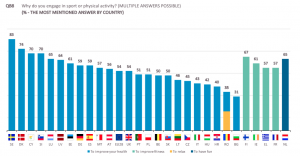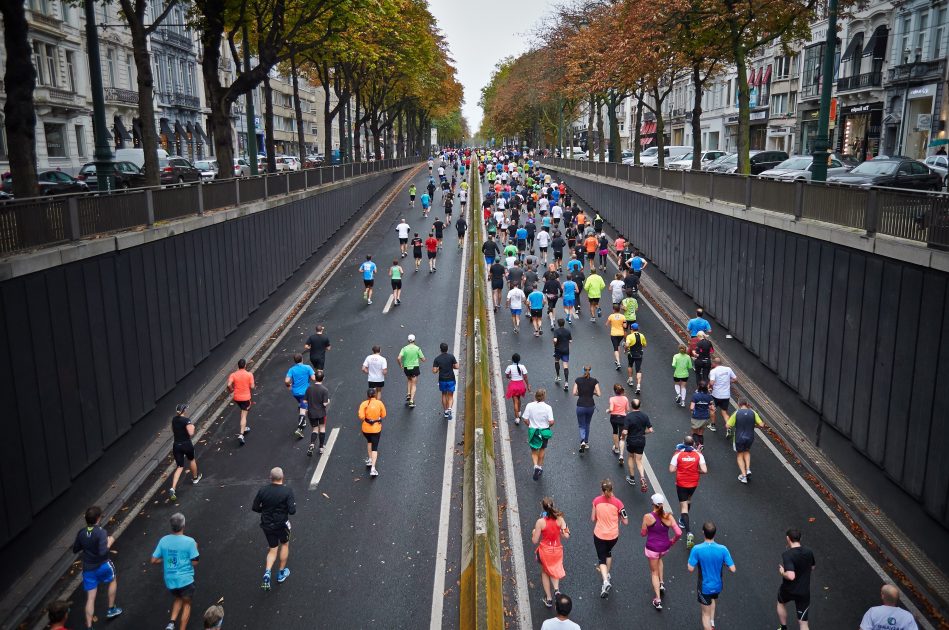What might incentivise us to walk, run and cycle more regularly is a question that’s long puzzled health bodies in the UK. Campaigns like Public Health England’s Health Matters have seen only limited success; as many as 39% of us – that’s 20 million people – remain “physically inactive”, defined as participating in less than 30 minutes of moderate intensity physical activity per week.
This, of course, has implications for population health: 66% of us are now overweight or obese with 12.3 million of us at elevated risk of developing Type 2 diabetes. We’re not alone in our inactivity either; according to the EU Commission’s 2018 Eurobarometer report on sport and physical activity, governments and health bodies throughout the continent face similar challenges.
There’s one country in particular, though, that’s bucking the trend. Renowned for being home to more bicycles than people, the Netherlands is a country of highly enthusiastic walkers, runners and cyclists. 84% of Dutch people own a bicycle, and according to government figures, more than a quarter of all trips by Dutch residents are made on two wheels. In fact, the Dutch walk or cycle more often than almost any other country in Europe: 80% do so with at least some regularity, compared to the EU average of 44%.
So, what is it that makes the Dutch leave their cars at home?
“An important reason for our active lifestyle is that Dutch people are very aware of the positive impact of being active on psychosocial and physical health and happiness,” says Vera Wiegman of Menzis, Changing Health’s private health insurer partner in the Netherlands.
The link between physical activity and wellbeing is well documented. It’s little surprise, therefore, that Dutch residents report some of the highest levels of wellbeing in the world; the United Nations’ World Happiness Report, which has charted satisfaction with life in 156 countries across the globe each year since 2012, has never ranked the Netherlands lower than seventh.
“I do believe that our happiness is correlated to our higher activity levels,” Vera says. “The phenomenon isn’t age-bound – the [Eurobarometer] report shows that, contrary to EU averages, engagement in physical activity is the same across all age groups. Our physical activity is also often seen as a recreational activity, such as cycling or walking in nature, walking the dog and gardening.”
Indeed, the Netherlands is the only EU nation in which “having fun” is the most common reason for exercising; 65% of Dutch people say it’s their primary motivator to get out and get active. In the UK, by comparison, it appears we exercise because we feel we have to, rather than because we want to, with 54% of us doing so “to improve [our] health”.


[credit: Eurobarometer, EU Commission]
Perhaps that, then, is our problem in the UK: for us, exercise usually feels like a chore. But it doesn’t have to be that way.
“Adopting positive lifestyle habits is not about radical crash diets and gruelling gym routines,” says Changing Health’s Professor Mike Trenell. “Quite the opposite. The way to make a change that lasts is to find one you can sustain – one you can fit into your normal routine without struggling to keep it up.
“Turning exercise into something into something we can enjoy at the same time is one of the most effective motivators to get more active, whether that’s getting off the bus early and losing yourself in an audiobook, relishing some healthy competition at spin class or meeting new friends in dance or yoga groups.”
“Compared to most people in the EU, the Dutch citizen has a more structural, social way of engaging in physical activity, since we’re more likely to be a member of a sports club or fitness centre instead of being not committed to such an organisation,” agrees Vera.
“Dutch people are motivated to engage in physical activity to relax, have fun and be with friends.”
The science supports that view: one study into behaviour change for people with Type 2 diabetes, on which Changing Health’s programmes are based, explored which context of lifestyle change is most effective in facilitating long term success. Social influences came top, followed by social role and identity to a peer group.
“Everybody’s routine, circumstances and personal preferences are different, and we should take these individual factors into account when recommending lifestyle changes,” Professor Trenell says. “But almost everybody can find a form of physical activity they can enjoy, and perhaps share with others; it’s just a matter of working out what that activity is. Taking a leaf out of the Netherlands’ book could well be the key to improving our health and wellbeing as a whole nation.”
Read more about motivation to make lifestyle changes in Changing Health’s white paper, Personalisation: the secret ingredient to lasting lifestyle change.




